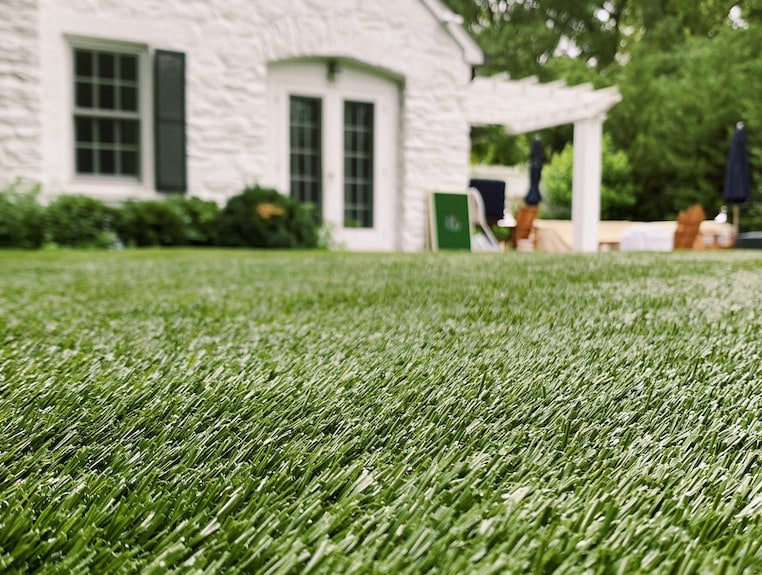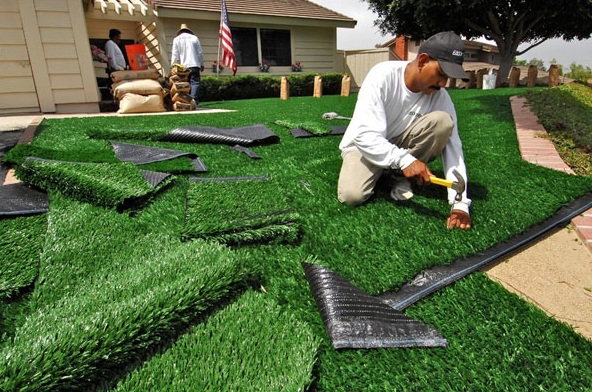Durable Arizona Artificial Turf for Residential and Commercial Applications
Durable Arizona Artificial Turf for Residential and Commercial Applications
Blog Article
Explore the Environmental Conveniences of Opting for Artificial Turf Solutions
The adoption of synthetic turf remedies offers a compelling chance to deal with pressing ecological obstacles. By considerably lowering water use and reducing the application of hazardous chemicals, these alternatives not just promote lasting landscape design yet additionally secure regional communities. Moreover, the reduced carbon footprint connected with lowered maintenance tasks adds to a more lasting strategy to land monitoring. Nevertheless, the implications of these advantages expand beyond simple conservation initiatives, raising questions concerning their long-term effect on habitat conservation and overall eco-friendly balance. Exploring these measurements exposes an intricate interaction worth thinking about.
Water Conservation Conveniences
One of the most substantial benefits of fabricated lawn is its capability to preserve water. In contrast, fabricated turf does not require watering, significantly decreasing the overall need for water resources.
By getting rid of the demand for routine watering, synthetic grass adds to lasting landscape techniques and aids reduce the ecological impact of too much water consumption. The preservation of water extends to the reduction of runoff, which can lead to soil disintegration and river contamination.
In addition, the setup of synthetic grass allows districts and home owners to assign water resources extra efficiently, concentrating on vital uses such as alcohol consumption water and farming. The shift in the direction of synthetic grass not just promotes accountable water usage but also aligns with broader environmental goals targeted at protecting natural deposits.
As neighborhoods increasingly prioritize sustainability, the water conservation advantages of artificial grass provide an engaging instance for its adoption in residential and business landscaping jobs.
Lowered Chemical Use
The change to synthetic grass dramatically decreases the reliance on chemical therapies typically used in natural yard upkeep. Standard turf management generally includes the application of herbicides, fertilizers, and chemicals to promote development and control parasites. These chemicals can pose dangers to human wellness, neighborhood wild animals, and the environment, adding to dirt and water contamination.
On the other hand, man-made grass eliminates the need for these hazardous materials. As soon as mounted, it needs very little upkeep, mostly including routine cleansing and seldom infill replenishment. This reduction in chemical usage not only benefits the prompt setting yet also adds to broader environmental security. By reducing the release of synthetic compounds right into the ecosystem, synthetic turf advertises healthier soil and water supply.
Furthermore, the absence of chemical drainage linked with man-made lawn installments assists protect local waterways from pollution, sustaining water life and keeping biodiversity. Arizona turf. As neighborhoods progressively prioritize lasting practices, going with artificial turf presents a viable service that lines up with environmental preservation goals. Via this change, building proprietors can take pleasure in lavish eco-friendly spaces without jeopardizing environmental wellness, leading the way for a much more sustainable future
Reduced Carbon Footprint

Additionally, the installment of synthetic grass can cause considerable water conservation. Natural lawns call for considerable amounts of water for watering, which not only adds to the carbon impact linked with water extraction and treatment yet likewise pressures local water resources. In comparison, synthetic grass requires minimal maintenance, calling for no watering, consequently considerably reducing water usage and its associated energy expenses.
Additionally, the long life of synthetic grass contributes to its reduced carbon effect. With a life expectancy of up to 15 years or even more, the demand for regular replacements is lessened, resulting in less waste and reduced energy usage in manufacturing and throwing away conventional yard choices. Overall, man-made turf offers a lasting choice for environmentally mindful landscaping.
Habitat Preservation
Habitat preservation is a crucial consideration in the dispute over landscaping this content options, specifically when comparing synthetic turf to natural grass. Natural yard lawns commonly require comprehensive maintenance, consisting of the usage of plant foods, herbicides, and chemicals, which can adversely influence local ecosystems. These chemicals can seep into the dirt and waterways, harming indigenous vegetation and fauna and disrupting local habitats.
Fabricated lawn gets rid of the requirement for harmful chemicals, thereby protecting nearby wildlife and preserving the integrity Full Article of surrounding environments. The setup of synthetic grass can lead to the conversion of previous yard locations right into even more biodiverse landscapes, such as pollinator yards or native plant areas, which can support neighborhood wild animals.
Ultimately, the change to man-made lawn not only saves water and lowers maintenance efforts but also promotes a much more harmonious partnership in between human tasks and the native environment, advertising environment conservation while doing so.
Long-Term Sustainability
Long-term sustainability is an important factor in examining the benefits of synthetic grass over traditional yard yards. Among the most considerable benefits of fabricated grass is its resilience; it can last approximately 15-20 years with marginal upkeep, whereas all-natural turf calls for constant reseeding and substitute. This longevity reduces the requirement for continuous sources, such as water, plant foods, and chemicals, which are vital for maintaining a healthy and balanced turf yard.
Furthermore, synthetic grass adds to a decrease in carbon emissions associated with lawn treatment equipment. Standard grass typically need gas-powered mowers, trimmers, and blowers, every one of which add to air pollution. Arizona artificial turf. In comparison, synthetic grass gets rid of the requirement for such equipment, advertising a cleaner atmosphere
Moreover, the production of artificial lawn progressively makes use of recycled materials, boosting its sustainability profile. As producers embrace environment-friendly techniques, the environmental impact of synthetic grass proceeds to diminish.

Final Thought
The adoption of synthetic grass remedies presents substantial ecological benefits, including significant water conservation, reduced dependence on hazardous chemicals, and a reduced carbon impact. Fabricated lawn help in protecting natural environments by lessening land disturbance and promoting lasting sustainability with the usage of sturdy products. Jointly, these elements click here for info underscore the capacity of synthetic grass to add favorably to environmental health and offer a practical option to typical landscaping methods in an increasingly resource-conscious world.
In comparison, fabricated turf does not require watering, substantially lowering the total demand for water sources. By decreasing the release of synthetic substances right into the environment, fabricated turf promotes healthier soil and water systems.
In addition, the installation of synthetic lawn can result in substantial water preservation. In comparison, fabricated lawn needs minimal maintenance, needing no watering, thereby substantially decreasing water use and its connected power expenses.

Report this page